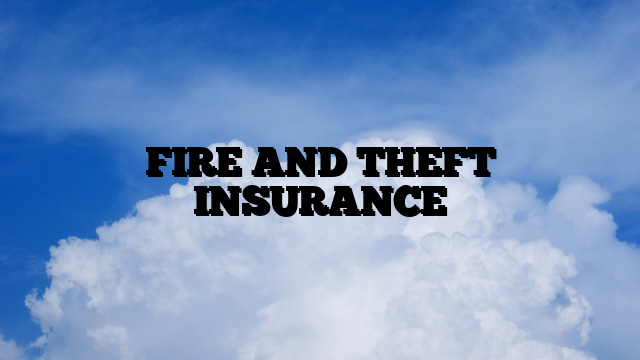
Fire and Theft Insurance is a type of property insurance that specifically covers damage to property caused by fire and loss or damage resulting from theft. It is often an add-on or a component of a more comprehensive insurance policy, such as a home or auto insurance policy. This coverage is valuable for protecting your property from two common and potentially devastating events: fire and theft.
Key Features of Fire and Theft Insurance:
- Fire Coverage:
- Damage to Property: If your property (home, vehicle, or business) is damaged or destroyed by fire, this part of the insurance will cover the costs of repair or replacement. This can include structural damage, damages to belongings, and in some cases, temporary accommodation or living expenses if the property becomes uninhabitable.
- Cause of Fire: It typically covers fires resulting from a wide range of causes, including accidental fires, electrical faults, and certain natural disasters (like lightning strikes). However, it may not cover intentional acts (e.g., arson) unless specifically stated.
- Additional Coverage: Some fire and theft policies may cover smoke damage, water damage from firefighting efforts, or loss of personal items within the property, depending on the terms.
- Theft Coverage:
- Loss of Property: If your property is stolen (e.g., items in your home or business, or a vehicle), the policy compensates you for the stolen property’s value, up to the insured amount. This can include electronics, furniture, vehicles, and other valuables.
- Burglary and Vandalism: Fire and theft insurance may also cover damages caused by burglary, including broken windows or doors, and damage done during the theft. However, the policy may have certain exclusions if theft occurred due to negligence (e.g., leaving windows unlocked).
- Robbery vs. Theft: It’s important to differentiate between “theft” (someone steals your property) and “robbery” (theft with the use of force or intimidation). Fire and theft insurance typically covers theft but may have separate clauses for robbery, which may require additional coverage.
Common Types of Fire and Theft Insurance:
- Home Insurance: Fire and theft are usually core components of home insurance. This insurance policy covers both the structure of your home (fire damage) and personal possessions inside (theft).
- Contents Insurance: This part of home insurance focuses on personal belongings, covering the loss of items inside the home due to fire or theft.
- Building Insurance: Covers the physical structure of the home from fire damage.
- Auto Insurance: In the context of motor insurance, fire and theft coverage is an option in many policies. It protects against damage caused by fire (such as a car fire) and loss or damage due to theft.
- Comprehensive Car Insurance: Often includes fire and theft coverage as part of the overall package, in addition to covering damage from accidents or vandalism.
- Business Insurance: Fire and theft insurance is also available for businesses to cover potential losses. This can include covering the building (if owned), inventory, equipment, and other property essential to operations. Business owners can choose between property insurance and business interruption insurance, which can help cover losses if a business must close due to fire or theft.
What Fire and Theft Insurance Does Not Cover:
While fire and theft insurance covers a lot of potential losses, there are often certain exclusions or limitations. Here are a few things that might not be covered:
- Intentional Damage: If the fire was caused deliberately (arson) or if the theft was staged, the claim may be denied.
- Wear and Tear: Insurance typically doesn’t cover damage from normal wear and tear. For example, if a roof deteriorates over time, this wouldn’t be covered under fire damage.
- Certain Causes of Fire: Some policies may exclude specific causes of fire, such as certain industrial or manufacturing processes that involve high risk.
- Uninsured Property: Items not listed in the policy or those with low value may not be covered.
- Floods and Earthquakes: Fire and theft insurance often does not include coverage for natural disasters like floods, earthquakes, or landslides unless explicitly stated.
Factors That Affect Fire and Theft Insurance Premiums:
Several factors can influence the cost of fire and theft insurance premiums:
- Type and Value of Property: More valuable property (e.g., a luxury car, high-end electronics, or a large home) will often require higher premiums because the potential payout in the event of a claim will be higher.
- Location: Properties located in areas prone to fire hazards or high crime rates may have higher premiums due to the increased risk of fire or theft.
- Security Features: If your property has fire alarms, burglar alarms, security cameras, or a sprinkler system, it may lower your premiums since these systems reduce the risk of damage from fire or theft.
- Building Materials and Age: Older homes or buildings that use flammable materials may face higher premiums. On the other hand, properties built with fire-resistant materials may attract lower premiums.
- Claims History: A history of frequent insurance claims (such as for past fires or thefts) can lead to higher premiums.
- Deductibles: Opting for a higher deductible (the amount you pay out-of-pocket before insurance kicks in) can reduce your premiums. However, this means you’ll pay more in the event of a claim.
How to File a Fire and Theft Insurance Claim:
If you experience a fire or theft, follow these general steps to file a claim:
- Notify Authorities: For theft, you should file a police report immediately. For fire damage, contact the fire department. This is necessary for documentation and proof of the incident.
- Document the Loss: Take photos or videos of the damage caused by fire or theft. Create an inventory of stolen or damaged items, including receipts, serial numbers, or other proof of ownership.
- Notify Your Insurer: Contact your insurance company as soon as possible to report the fire or theft. They will guide you on how to proceed with the claims process.
- Assessment and Investigation: An insurance adjuster may visit the site to assess the damage and evaluate the claim. The insurer will then process your claim based on the terms of the policy.
- Approval and Payout: Once the claim is approved, the insurance company will provide compensation based on the policy’s coverage limits, subject to any exclusions, deductibles, and conditions.


